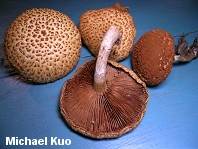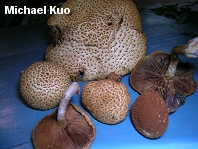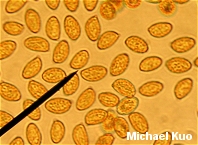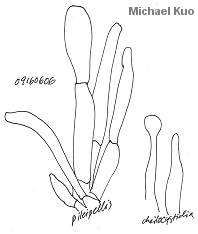| Major Groups > Gilled Mushrooms > Dark-Spored > Gymnopilus > Gymnopilus fulvosquamulosus |

|
Gymnopilus fulvosquamulosus [ Basidiomycetes > Agaricales > by Michael Kuo Most of our continent's 100 or so named species of Gymnopilus are boring little yellow- to orangish- or brownish-capped guys that grow on logs. The imminently forgettable Gymnopilus liquiritiae, the type species for the genus, makes a pretty good representative for the masses. But Gymnopilus fulvosquamulosus, with its gorgeous, contrasting scales, stands out from the crowd. The scales, however, increase the potential for confusion with species of Pholiota, especially since Gymnopilus fulvosquamulosus is rarely treated in field guides, leaving only the scaly Pholiota species as plausible matches. But the spore print in Pholiota is usually a browner shade of brown than the orange-brown to rusty brown print of Gymnopilus fulvosquamulosus--and, under the microscope, the warty spores of this species easily separate it from Pholiota, which has smooth spores. Description: Ecology: Saprobic on the dead wood hardwoods (possibly also on conifer wood); growing alone, gregariously, or in small clusters; summer and fall; apparently widely distributed in eastern North America (from Michigan to Missouri and Mississippi) and in Mexico. Cap: 3-13 cm; convex becoming planoconvex or nearly flat; dry; covered with prominent tawny scales composed of aggregated fibrils; ground color under the scales pale yellow; the margin somewhat inrolled, at least when young. Gills: Attached to the stem or beginning to run down it; close; pale to medium yellow, developing cinnamon to rusty spots and eventually becoming rusty overall; when very young covered by a cortina-like partial veil. Stem: 3-8 cm long; up to 1.5 cm thick; more or less equal, or with a slightly swollen base; pale yellow when young, discoloring rusty brown with age or on handling; finely hairy; with a very ephemeral and easily disappearing ring or ring zone near the apex. Flesh: Whitish to pale yellow. Odor and Taste: Taste bitter; odor not distinctive. Spore Print: Rusty brown to orange-brown. Chemical Reactions: KOH red on cap surface, black on the pigmented scales. Iron salts slowly olive on flesh. Microscopic Features: Spores 7-10 x 5-5.5 µ; warty; more or less elliptical; dextrinoid. Pleurocystidia and cheilocystidia both present (but the former scarcely projecting beyond the basidia); variously shaped. Pileipellis a tangled cutis with elements occasionally aggregated into trichoderm-like bundles; pileocystidia absent. REFERENCES: Hesler, 1969. (Hesler, 1969; Weber & Smith, 1985; Guzmán-Dávalos & Guzmán, 1995.) Herb. Kuo 09160606. This website contains no information about the edibility or toxicity of mushrooms. |
© MushroomExpert.Com |
|
Cite this page as: Kuo, M. (2007, February). Gymnopilus fulvosquamulosus. Retrieved from the MushroomExpert.Com Web site: http://www.mushroomexpert.com/gymnopilus_fulvosquamulosus.html |



